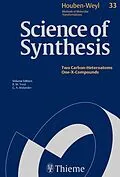Science of Synthesis provides a critical review of the synthetic methodology developed from the early 1800s to date for the entire field of organic and organometallic chemistry. As the only resource providing full-text descriptions of organic transformations and synthetic methods as well as experimental procedures, Science of Synthesis is therefore a unique chemical information tool. Over 1000 world-renowned experts have chosen the most important molecular transformations for a class of organic compounds and elaborated on their scope and limitations. The systematic, logical and consistent organization of the synthetic methods for each functional group enables users to quickly find out which methods are useful for a particular synthesis and which are not. Effective and practical experimental procedures can be implemented quickly and easily in the lab.// The content of this e-book was originally published in December 2006.
Autorentext
B.M. Trost, G.A. Molander
Zusammenfassung
Science of Synthesis: Houben-Weyl Methods of Molecular Transformations is the entirely new edition of the acclaimed reference series Houben-Weyl, the standard synthetic chemistry resource since 1909. This new edition is published in English and will comprise 48 volumes published between the years 2000 and 2008.
Science of Synthesis is a quality reference work developed by a highly esteemed editorial board to provide a comprehensive and critical selection of reliable organic and organometallic synthetic methods. This unique resource is designed to be the first point of reference when searching for a synthesis strategy.
- Contains the expertise of presently 400 leading chemists worldwide
- Critically evaluates the preparative applicability and significance of the synthetic methods
- Discusses relevant background information and provides detailed experimental procedures
For full information on the Science of Synthesis series, visit the Science of Synthesis Homepage
Inhalt
33.1 Product Class 1: Alk-1-enyl Sulfur Compounds
33.1.1 Product Subclass 1: Alk-1-enesulfonic Acids and Derivatives
33.1.2 Product Subclass 2: Alk-1-enyl Sulfones
33.1.3 Product Subclass 3: S-Alk-1-enylsulfoximides
33.1.4 Product Subclass 4: Alk-1-enesulfinic Acids and Derivatives
33.1.5 Product Subclass 5: Alk-1-enyl Sulfoxides, Sulfimides, and Related Compounds
33.1.6 Product Subclass 6: Alk-1-enethiols
33.1.7 Product Subclass 7: Metal Alk-1-enethiolates
33.1.8 Product Subclass 8: Alk-1-enyl Sulfides
33.1.9 Product Subclass 9: Alk-1-enylsulfonium Salts
33.1.10 Product Subclass 10: Alk-1-enesulfenic Acid Derivatives
33.1.11 Product Subclass 11: Alk-1-enyl Disulfides
33.1.12 Product Subclass 12: Thietes and Derivatives
33.1.13 Product Subclass 13: 2,3-Dihydrothiophenes and Derivatives
33.1.14 Product Subclass 14: 3,4-Dihydro-2H-thiopyrans and Derivatives
33.1.15 Product Subclass 15: 2,3,4,5-Tetrahydrothiepins, Larger Rings, and Derivatives
33.2 Product Class 2: Alk-1-enyl Selenium Compounds
33.3 Product Class 3: Alk-1-enyl Tellurium Compounds
33.4 Product Class 4: Alk-1-enyl Nitrogen Compounds
33.4.1 Product Subclass 1: 1-Nitroalkenes
33.4.2 Product Subclass 2: 1-Nitrosoalkenes
33.4.3 Product Subclass 3: N-Alk-1-enyliminosulfur Compounds
33.4.4 Product Subclass 4: Alk-1-enediazonium Salts, Alkeneazoxy,
33.4.5 Product Subclass 5: N-Alk-1-enyliminophosphorus Compounds
33.4.6 Product Subclass 6: Enamines
33.4.7 Product Subclass 7: Enammonium Salts
33.4.8 Product Subclass 8: N-Silylenamines
33.4.9 Product Subclass 9: N-Borylenamines
33.4.10 Product Subclass 10: N-Haloenamines
33.4.11 Product Subclass 11: N-Alk-1-enylhydroxylamines
33.4.12 Product Subclass 12: N-Alk-1-enylaminosulfur Compounds
33.4.13 Product Subclass 13: Alk-1-enylhydrazines
33.4.14 Product Subclass 14: Alk-1-enyl Azides
33.4.15 Product Subclass 15: N-Alk-1-enylaminophosphorus Compounds
33.4.16 Product Subclass 16: 1,2-Dihydroazetes and Derivatives
33.4.17 Product Subclass 17: 2,3-Dihydro-1H-pyrroles and Derivatives
33.4.18 Product Subclass 18: 1,2-Dihydropyridines, 1,4-Dihydropyridines, and Derivatives
33.4.19 Product Subclass 19: 1,2,3,4-Tetrahydropyridines and Derivatives
33.4.20 Product Subclass 20: 2,3,4,5-Tetrahydro-1H-azepines, Larger Rings, and Derivatives
33.5 Product Class 5: Alk-1-enyl Phosphorus Compounds
33.5.1 Product Subclass 1: Alk-1-enylphosphonic Acids and Derivatives
33.5.2 Product Subclass 2: Alk-1-enylphosphinic Acids and Derivatives
33.5.3 Product Subclass 3: Alk-1-enylphosphine Oxides and Derivatives
33.5.4 Product Subclass 4: Alk-1-enylphosphines
33.5.5 Product Subclass 5: Alk-1-enylphosphonium Salts
33.5.6 Product Subclass 6: P-Heteroatom-Substituted Alk-1-enylphosphines
33.5.7 Product Subclass 7: 1,2-Dihydrophosphetes and Derivatives
33.5.8 Product Subclass 8: 2,3-Dihydro-1H-phospholes and Derivatives
33.5.9 Product Subclass 9: 1,2,3,4-Tetrahydrophosphinines and Derivatives
33.5.10 Product Subclass 10: 1,4-Dihydrophosphinines and Derivatives
